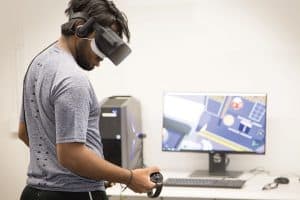
Virtual reality (VR) and augmented reality (AR) are important technologies that continue to evolve, grow, and integrate into the lives of our library users. VR is the immersion of a user into a completely simulated environment, while AR overlays digital information on the user’s real-world environment. Many libraries have adopted both as educational and exploratory tools.
Budget-friendly VR and AR devices are available that can reach a broad spectrum of library users. One option launched in 2014 is still useful: Google Cardboard. Using a combination smartphone and simple viewer, the Cardboard headset allows patrons to experience a multitude of low-level VR applications. While not comprehensive, it does offer a taste of the virtual experience. Google made some improvements to this type of device with its 2016 introduction of Daydream, an advanced version of Cardboard that comes with a controller and requires a smart device with enhanced optics.
Another product that runs on the Daydream platform is the Lenovo Mirage Solo, a self-contained headset that requires only a Google account, not an external device such as a smartphone. Because they are mobile and easy to circulate, these headsets are useful for libraries with limited space.
If both space and budget suffice, more intensive VR devices such as Oculus Rift and HTC Vive are good options. While the devices themselves are more expensive, they make up for the price difference through better graphics and motion sensors that create a more immersive experience. They also use SteamVR, a gaming platform with several free and paid options for virtual reality. Drawbacks include the need for a space large enough to set up the device and a computer with an advanced graphics card. While mobile options are available, the setup is more difficult to implement. The devices work best when installed in a permanent space.
If both space and budget suffice, more intensive VR devices such as Oculus Rift are good options.
VR and AR can be implemented in all types of libraries. If you are considering starting a program, keep in mind the following:
- Budget. Options that can provide a variety of different experiences are available for libraries on a tight budget.
- Space. When selecting hardware, you will need to know whether you will have a dedicated space within the library or will be restricted to mobile devices.
- User base. There are many types of VR and AR experiences, and libraries should decide which ones they want to provide before making any purchasing decisions. Would your users like an immersive experience or an augmented experience that incorporates their real surroundings? Certain devices are better equipped to handle different experiences.
- Staffing options. Make sure that there is enthusiasm among your staff members for specific devices, as they will require some form of tech support. If there isn’t much interest, it could be difficult to get any sort of program started.
- Have an open mind. Explore all the interesting applications that are available. Certain applications are available on some but not all platforms. Examples include the Steam platform, the Oculus store, iOS and Android app stores, and the HTC Viveport. Determining whether certain games are available for your platform can help in deciding which devices to invest in.
By incorporating VR and AR devices and programs, libraries can offer access to these technologies and create unique learning and experiential opportunities for their users.


